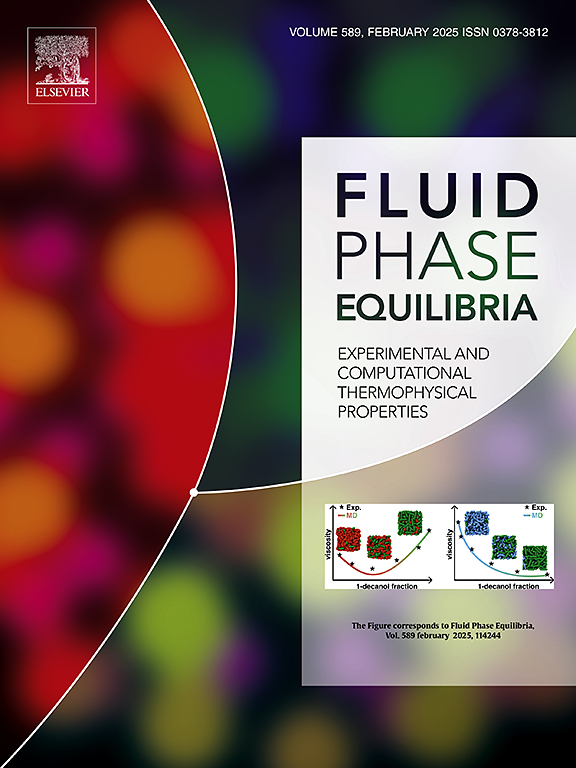Thermodynamic description of aqueous solutions of silver nitrate: Experimental and modeling
IF 2.7
3区 工程技术
Q3 CHEMISTRY, PHYSICAL
引用次数: 0
Abstract
The water activity of silver nitrate solutions was measured at 298.2 K and 313.2 K using a humidity sensor instrument. Concentrations of silver nitrate up to almost saturation were included. The thermodynamic properties of the system were described by the Pitzer model, the specific interaction theory (SIT), and the Extended UNIQUAC model. The interaction parameters for the models were estimated using experimental freezing points, osmotic coefficients, and solubility for silver nitrate aqueous solutions collected from the open literature, as well as the water activity data measured in this work. Pitzer and SIT parameters were applied by introducing a temperature dependency, enabling these models to cover a more comprehensive temperature range and extrapolate the calculation to higher molalities. Both approaches represent the data satisfactorily up to moderate molalities. The Extended UNIQUAC model, with its built-in temperature dependence, provides the best thermodynamic description of this binary system. It has a very satisfactory solubility diagram and a good description of the osmotic and activity coefficients.
硝酸银水溶液的热力学描述:实验和模型
在298.2 K和313.2 K温度下,用湿度传感器测量了硝酸银溶液的水活度。硝酸银的浓度几乎达到饱和。用Pitzer模型、特定相互作用理论(SIT)和扩展UNIQUAC模型描述了体系的热力学性质。模型的相互作用参数是使用从公开文献中收集的硝酸银水溶液的实验冰点、渗透系数和溶解度以及本工作中测量的水活度数据来估计的。Pitzer和SIT参数通过引入温度依赖关系来应用,使这些模型能够覆盖更全面的温度范围,并将计算外推到更高的摩尔浓度。两种方法都能令人满意地表示数据,达到中等质量摩尔浓度。扩展的UNIQUAC模型,其内置的温度依赖,提供了最好的热力学描述这个双星系统。它有一个非常令人满意的溶解度图和一个很好的描述渗透和活度系数。
本文章由计算机程序翻译,如有差异,请以英文原文为准。
求助全文
约1分钟内获得全文
求助全文
来源期刊

Fluid Phase Equilibria
工程技术-工程:化工
CiteScore
5.30
自引率
15.40%
发文量
223
审稿时长
53 days
期刊介绍:
Fluid Phase Equilibria publishes high-quality papers dealing with experimental, theoretical, and applied research related to equilibrium and transport properties of fluids, solids, and interfaces. Subjects of interest include physical/phase and chemical equilibria; equilibrium and nonequilibrium thermophysical properties; fundamental thermodynamic relations; and stability. The systems central to the journal include pure substances and mixtures of organic and inorganic materials, including polymers, biochemicals, and surfactants with sufficient characterization of composition and purity for the results to be reproduced. Alloys are of interest only when thermodynamic studies are included, purely material studies will not be considered. In all cases, authors are expected to provide physical or chemical interpretations of the results.
Experimental research can include measurements under all conditions of temperature, pressure, and composition, including critical and supercritical. Measurements are to be associated with systems and conditions of fundamental or applied interest, and may not be only a collection of routine data, such as physical property or solubility measurements at limited pressures and temperatures close to ambient, or surfactant studies focussed strictly on micellisation or micelle structure. Papers reporting common data must be accompanied by new physical insights and/or contemporary or new theory or techniques.
 求助内容:
求助内容: 应助结果提醒方式:
应助结果提醒方式:


